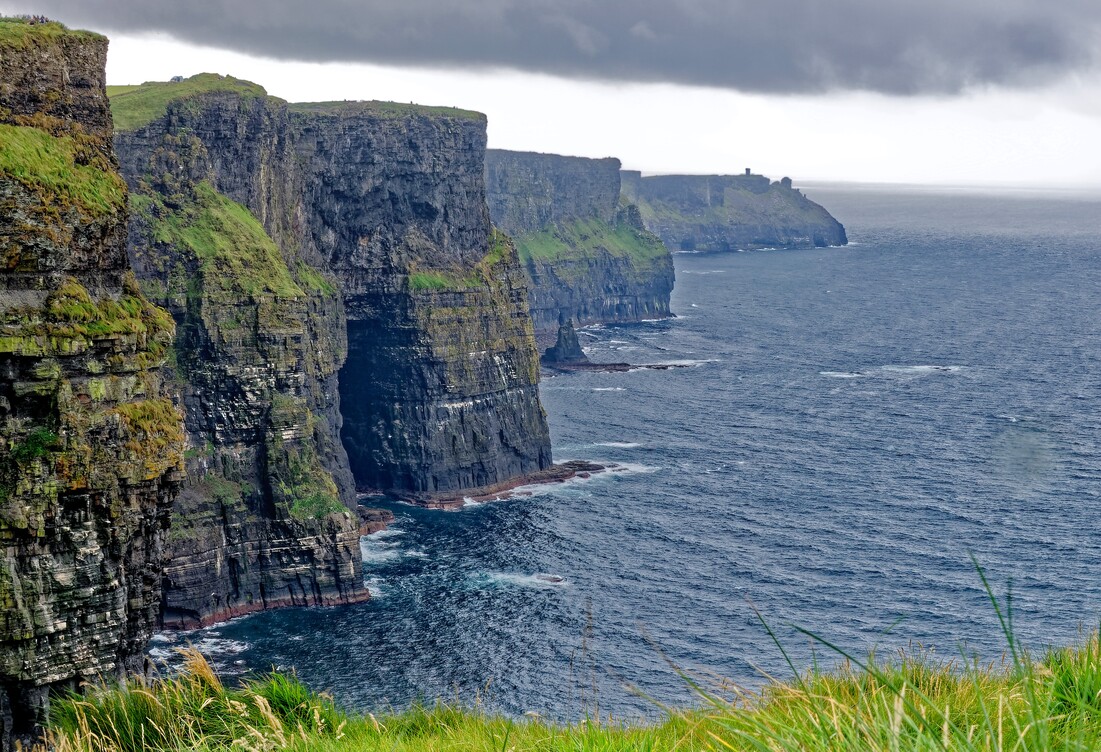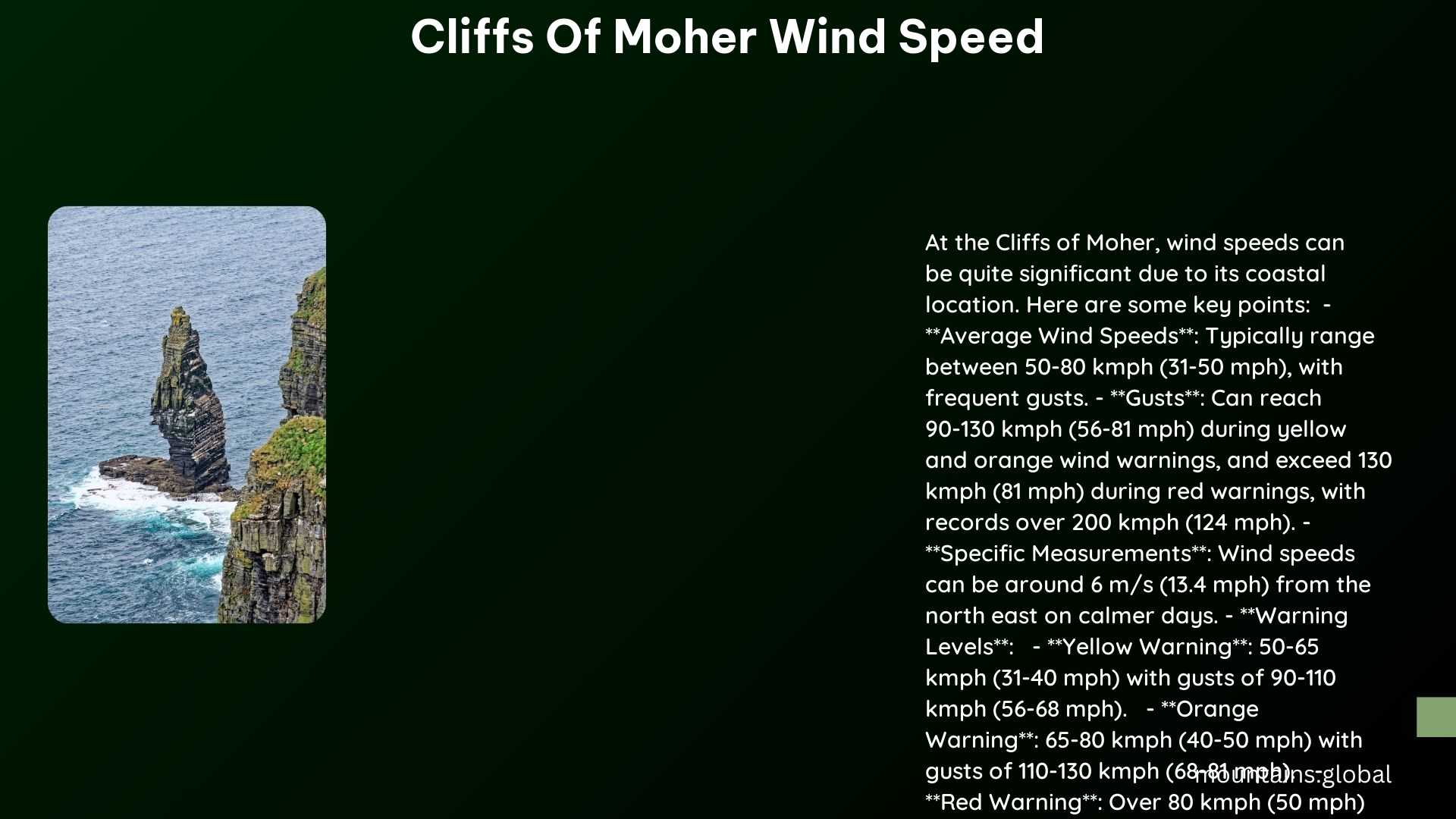The Cliffs of Moher, renowned for their breathtaking beauty, are equally famous for their powerful winds. With average speeds ranging from 50 to 65 km/h and gusts often exceeding these values, the wind at the Cliffs of Moher is a force to be reckoned with. This natural phenomenon significantly impacts visitor experiences, safety considerations, and the overall atmosphere of this iconic Irish landmark. Understanding the wind patterns and their implications is crucial for anyone planning to visit this majestic site.
What Are the Current Wind Conditions at the Cliffs of Moher?

As of Sunday, September 29, 2024, the wind conditions at the Cliffs of Moher are characterized by fresh winds, with the strongest gusts expected to reach around 35 mph (approximately 56 km/h) from an easterly direction during the afternoon. This day is also forecasted to have the most precipitation, with an accumulation of about 9.0mm, contributing to potentially hazardous conditions for visitors.
How Do Wind Speeds Vary Throughout the Year?

Wind speeds at the Cliffs of Moher fluctuate throughout the year, influenced by seasonal weather patterns and local topography. Here’s a breakdown of typical wind conditions by season:
- Spring (March to May)
- Average wind speeds: 40-55 km/h
- Gusts can reach up to 80-90 km/h
-
Conditions tend to be milder compared to winter
-
Summer (June to August)
- Average wind speeds: 30-45 km/h
- Gusts typically range from 60-75 km/h
-
Generally the calmest season, but still windy by most standards
-
Autumn (September to November)
- Average wind speeds: 45-60 km/h
- Gusts can exceed 100 km/h during storms
-
Wind speeds begin to increase as winter approaches
-
Winter (December to February)
- Average wind speeds: 50-70 km/h
- Gusts can surpass 120 km/h during severe weather events
- The windiest season, with frequent storms and high winds
What Are the Different Wind Speed Categories and Their Associated Risks?
The Cliffs of Moher use a color-coded warning system to categorize wind speeds and their associated risks. Understanding these categories is crucial for visitor safety:
| Warning Level | Wind Speed (Average) | Wind Speed (Gusts) | Associated Risks |
|---|---|---|---|
| Yellow | 50-65 km/h | 90-110 km/h | Exhilarating but not advisable for those with mobility issues or small children |
| Orange | 65-80 km/h | 110-130 km/h | Real danger, risk of shale pieces being hurled over the cliff |
| Red | >80 km/h | >130 km/h | Extremely hazardous, visitor center may close |
How Does Wind Speed Impact Visitor Experiences?
The wind speed at the Cliffs of Moher significantly influences the visitor experience in several ways:
-
Safety Concerns: High winds increase the risk of accidents, especially for those who venture too close to the cliff edge.
-
Visibility: Strong winds can kick up sea spray and mist, potentially obscuring views of the cliffs and surrounding landscape.
-
Comfort Level: Even moderate winds can make it challenging to walk, take photos, or simply enjoy the scenery comfortably.
-
Tour Availability: Extreme winds may lead to the cancellation of boat tours or guided walks along the cliffs.
-
Sound Experience: The howling of the wind adds a dramatic auditory element to the visit, enhancing the wild and rugged atmosphere of the cliffs.
What Precautions Should Visitors Take During High Wind Conditions?
To ensure a safe and enjoyable visit to the Cliffs of Moher during windy conditions, consider the following precautions:
- Check the weather forecast and wind speed warnings before your visit
- Dress appropriately in warm, waterproof layers
- Wear sturdy, non-slip footwear
- Stay on designated paths and behind safety barriers at all times
- Keep a safe distance from the cliff edge, especially during strong gusts
- Hold onto children and keep pets on a leash
- Secure loose items like hats, scarves, or camera equipment
- Be prepared to adjust your plans if conditions become too severe
How Has Wind Speed Shaped the Cliffs of Moher Over Time?
The relentless winds at the Cliffs of Moher have played a significant role in shaping the landscape over millions of years:
-
Erosion: Wind-driven waves and rain contribute to the erosion of the cliff face, gradually sculpting the dramatic formations we see today.
-
Vegetation: The constant wind has influenced the types of plants that can survive on the cliffs, resulting in a unique ecosystem adapted to these harsh conditions.
-
Rock Formations: Wind erosion has helped create distinctive features like sea stacks and arches along the coastline.
-
Sediment Distribution: Strong winds carry fine particles of rock and soil, redistributing them across the landscape and contributing to soil formation in sheltered areas.
What Are Some Interesting Wind-Related Facts About the Cliffs of Moher?
-
The Cliffs of Moher have experienced wind speeds in excess of 200 km/h during severe storms, showcasing the extreme weather conditions that can occur at this site.
-
The wind at the cliffs is so consistent that it has been considered as a potential site for wind energy generation, although environmental concerns have prevented such developments.
-
Local folklore includes tales of the wind at the Cliffs of Moher, with some stories claiming that on particularly windy days, the spirits of ancient warriors can be heard in the gusts.
-
The wind patterns at the cliffs create unique microclimates that support rare plant species found nowhere else in Ireland.
-
Birdwatchers often visit the cliffs to observe seabirds like puffins and guillemots, which use the strong updrafts for effortless flight.
How Can Visitors Monitor Wind Speeds at the Cliffs of Moher?
Staying informed about wind conditions is crucial for a safe and enjoyable visit. Here are some ways to monitor wind speeds:
-
Official Website: The Cliffs of Moher visitor center website provides up-to-date weather information, including wind speeds and warnings.
-
Weather Apps: Many smartphone weather apps offer detailed wind forecasts for the area.
-
Local Weather Stations: Nearby weather stations in County Clare provide real-time wind data that can be accessed online.
-
On-Site Information: The visitor center displays current weather conditions and wind speed information.
-
Tour Operators: If you’re booking a guided tour, operators often have access to the latest weather updates and can advise on conditions.
What Role Does Wind Speed Play in the Cliffs of Moher Ecosystem?
The wind at the Cliffs of Moher is not just a challenge for visitors; it’s a vital component of the local ecosystem:
-
Plant Adaptation: The constant wind has led to the evolution of wind-resistant plant species that thrive in this harsh environment.
-
Bird Habitats: Seabirds like guillemots and razorbills use the updrafts created by the wind to nest on narrow ledges along the cliff face.
-
Marine Life: Wind-driven waves and currents influence the distribution of nutrients in the water, supporting a diverse marine ecosystem at the base of the cliffs.
-
Soil Formation: Wind erosion and deposition contribute to the formation and distribution of soil across the cliff tops and surrounding areas.
-
Microclimate Creation: The interaction between wind and the cliff face creates unique microclimates that support specialized plant and animal communities.
Understanding the wind speed at the Cliffs of Moher is essential for both appreciating the natural forces that shape this iconic landscape and ensuring a safe and memorable visit. By staying informed about wind conditions and following safety guidelines, visitors can fully experience the awe-inspiring beauty of the cliffs while respecting the power of nature that surrounds them.
References:
1. Current Weather for Cliffs Of Moher
2. Weather at the Cliffs of Moher
3. Cliffs of Moher Travel Guide
